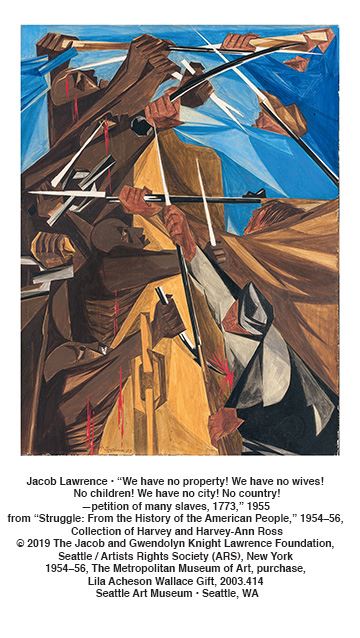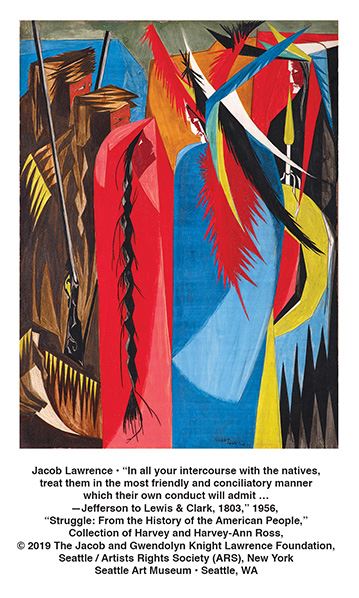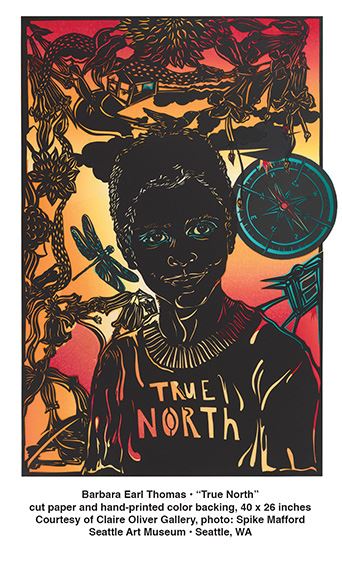
We are so fortunate in Seattle to have the only West Coast showing of Jacob Lawrence’s “The American Struggle,” a series of 30 panels created in the mid 1950s that re-think American history and American struggle. What could be more timely as we face so many struggles today.
 Although Lawrence includes some familiar figures, such as Paul Revere, or well-known events, such as the Boston Tea Party, his interpretation is so original, that we understand these events entirely differently. In the case of Paul Revere he is shown almost in the dark, with a black cloak, suggesting the secret nature of his ride, a stark contrast to the famous moonlight aerial view by Grant Wood. The insurgents at the Boston Tea Party are dressed as Mohawk Indians, factually true, but not much emphasized. In other words, if they are caught the Indians get blamed. We see Sacajawea, the famous Native who was the only woman on the Lewis and Clark expedition, reuniting with her brother in a stunning juxtaposition of the drab explorers and the colorful robes of the Natives.
Although Lawrence includes some familiar figures, such as Paul Revere, or well-known events, such as the Boston Tea Party, his interpretation is so original, that we understand these events entirely differently. In the case of Paul Revere he is shown almost in the dark, with a black cloak, suggesting the secret nature of his ride, a stark contrast to the famous moonlight aerial view by Grant Wood. The insurgents at the Boston Tea Party are dressed as Mohawk Indians, factually true, but not much emphasized. In other words, if they are caught the Indians get blamed. We see Sacajawea, the famous Native who was the only woman on the Lewis and Clark expedition, reuniting with her brother in a stunning juxtaposition of the drab explorers and the colorful robes of the Natives.
Throughout we see the meaninglessness of conflict, the sacrifice of those who fight, and the huge efforts of ordinary workers, as in the building of the Erie Canal. The movement West is seen with two oxen weighted down almost to the ground, as a metaphor for the struggle.
The dynamic compositions express struggle in every line. Most of us are familiar with Lawrence’s more realistic “Migration of the Negro,” 1940-41. “The American Struggle” still has the same small format, but the thrusting diagonals and dramatic spaces convey the meaning of each event. The color also creates rhythms and relationships. Clearly Lawrence absorbed the principles of the then-dominant Abstract Expressionists, but wedded abstraction to the realities of the bloody struggle for democracy.
As Lawrence worked on “Struggle,“ the 1954 Civil Rights Act banning segregation in public institutions passed in May, Emmett Till was lynched in August 1955 and Rosa Parks refused to give up her seat in December 1955. In the same years, government persecution was rampant as McCarthy saw communists everywhere. The FBI described Lawrence himself as “subversive” because he “propagandized alleged acts of racial discrimination of Negroes.”
Lawrence planned to continue through the Civil War and the Industrial Revolution up to 1908 when, as he specifies, “the American fleet sailed around the world.” But he created only half of the planned sixty works, stopping with the beginning of the movement West in 1817. He suspended work on the historical study of struggle in 1956, immersed in contemporary events, as well as his own financial and professional disruptions. He never completed the second thirty works, instead moving to the contemporary Civil Rights movement and other topics.
The series of 30 paintings have not been shown together since 1958: they were scattered for decades among private collectors. But as the finally re-assembled series went on exhibit last year, two more missing panels were discovered, Panel 16 “There are combustibles in every state that a spark might set fire to – Washington 26 December 1786” and Panel 28 “Immigrants Admitted from All Countries: 1820-1840,” both incredibly timely topics today.
The “American Struggle” also includes provocative work by three contemporary artists, Bethany Collins, Hank Willis Thomas, and Derrick Adams, each exploring aspects of struggle through contemporary media and perspectives.
 At the Seattle Art Museum we have the unique opportunity to go from Lawrence’s “Struggle” to Barbara Earl Thomas’s “The Geography of Innocence.” It offers a perfect partner and contrast to the bloody confrontations of “Struggle.” Thomas gives us instead an homage to the innocence of black children, who stand threatened and accused by their very existence. The shimmering installation with images of black children in shrine-like niches invokes a spiritual environment that encourages awareness of the fragility of black lives. The children are people whom Barbara Earl Thomas knows personally, based on photographs, subtly elaborated with cultural references. As she says “the face of the dark child…is often misread as older and wiser than his years or misinterpreted as hostile, angry, and cunning. With this work I offer an alternative view, one that brings the dark child into a definition of the every-child. I put my children in stances where each face might be considered an unwritten slate.”
At the Seattle Art Museum we have the unique opportunity to go from Lawrence’s “Struggle” to Barbara Earl Thomas’s “The Geography of Innocence.” It offers a perfect partner and contrast to the bloody confrontations of “Struggle.” Thomas gives us instead an homage to the innocence of black children, who stand threatened and accused by their very existence. The shimmering installation with images of black children in shrine-like niches invokes a spiritual environment that encourages awareness of the fragility of black lives. The children are people whom Barbara Earl Thomas knows personally, based on photographs, subtly elaborated with cultural references. As she says “the face of the dark child…is often misread as older and wiser than his years or misinterpreted as hostile, angry, and cunning. With this work I offer an alternative view, one that brings the dark child into a definition of the every-child. I put my children in stances where each face might be considered an unwritten slate.”
Barbara Earl Thomas was Jacob Lawrence’s student when he taught at the University of Washington. The connection between these two artists is thrilling.
Susan Noyes Platt
Susan Noyes Platt writes a blog www.artandpoliticsnow.com and for local, national, and international publications.
“Jacob Lawrence: The American Struggle” and “Barbara Earl Thomas: The Geography of Innocence” are on view at the Seattle Art Museum located at 1300 First Avenue in Seattle, Washington. For more information, visit www.seattleartmuseum.org.